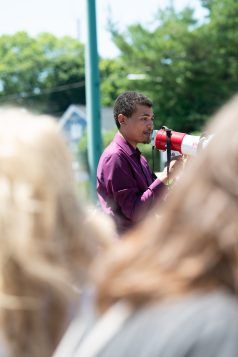The following incidents have been reported by Suffolk County Police:
Centereach
■ A resident on Buick Drive in Centereach reported that two unknown men broke the rear car window of his vehicle on June 22 and removed two iPhones valued at $800 and cash.
■ A resident on Anne Drive in Centereach reported a petit larceny on June 22. Three men were observed entered her unlocked vehicle in the driveway and removing cash from a wallet. That same day, a car window on Corvette Road in Centereach was broken and a wallet was stolen.
Commack
■ Marshall’s on Henry Street in Commack reported a petit larceny on June 24. Two men allegedly stole miscellaneous clothing valued at $170.
■ Costco on Garet Place in Commack called the police on June 24 to report a shoplifter. A man allegedly stole a 48” LG television valued at $900.
■ Walmart on Crooked Hill Road reported a shoplifter on June 22. A person allegedly stole various electronics and cleaning supplies valued at $550.
■ Commack Cigar & Vape on Commack Road in Commack was burglarized on June 19. Someone smashed the glass front door and stole various items valued at $2,000.
■ A woman shopping at Trader Joe’s on Jericho Turnpike in Commack on June 25 reported that someone stole her wallet from her pocketbook while it was in a shopping cart.
■ Home Depot on Jericho Turnpike in Commack reported a shoplifter on June 24. A person allegedly stole assorted Milwaukee tools valued at $100.
■ Walmart on Crooked Hill Road in Commack called the police on June 25 to report that two en allegedly stole miscellaneous merchandise valued at $500.
East Setauket
■ Walmart on Nesconset Highway in East Setauket reported a shoplifter on June 21. A man allegedly stole a Sharper Image drone and miscellaneous items valued at $80.
Huntington Station
■ Saks 5th Avenue on Walt Whitman Road in Huntington Station called the police on June 21 to report a grand larceny. A man and a woman allegedly stole Chanel sunglasses valued at $675 and used a sleight of hand to steal money from a cashier.
■ A 2020 Acura MDX was reported stolen from a residence on 3rd Avenue in Huntington Station on June 19. The vehicle was valued at $20,000.
Miller Place
■ A patron of McNulty’s on North Country Road in Miller Place reported that a wallet containing credit cards was stolen from his car parked in the parking lot on June 23.
■ Sonny’s Cards N’ Things on Route 25A in Miller Place reported a burglary on June 20. Someone smashed the glass front door and allegedly stole cash and lottery tickets.
Port Jefferson
■ A resident on Belle Terre Road in Port Jefferson called the police on June 22 to report that someone broke into their vehicle and stole headphones valued at $50.
Port Jefferson Station
■ A car was reported stolen from the driveway of a resident on Maple Avenue in Port Jefferson Station on June 22. The vehicle, a 2016 Lincoln MKZ, was valued at $18,000.
■ Speedway on Route 112 in Port Jefferson Station reported a burglary on June 20. A man allegedly broke the front glass door of the store overnight and stole numerous Newport cigarettes valued at $1100.
■ Uncle Giuseppe’s Marketplace on Route 112 in Port Jefferson Station reported a shoplifter on June 19. A man allegedly concealed food items including crab cakes, octopus salad, shrimp and steak in his jacket, went to the self-checkout, paid for several items but not what was in his jacket before fleeing. The items were valued at approximately $100.
■ A resident on Champlain Street in Port Jefferson Station reported that someone entered their unlocked vehicle parked in the street on June 18 and stole a wallet containing cash and credit cards. A second resident on the same street reported the same crime on June 19.
■ A resident on Peters Lane in Port Jefferson reported that someone entered his unlocked vehicle on June 18 and stole Apple AirPods and a wallet.
Rocky Point
■ A resident on Narcissus Road in Rocky Point reported that someone broke the window of her car on June 18 and stole a backpack with a laptop and sports gear.
■ A resident on Broadway in Rocky Point called the police on June 20 to report that someone removed a battery powered ATV Quad Razor valued at $600 from their property.
■ A resident on Rosewood Road in Rocky Point reported that someone entered his unlocked vehicle on June 18 and stole Apple iPods, backpack, and a wallet containing credit cards.
■ The rear passenger side window of a vehicle on Magnolia Drive in Rocky Point was reported broken on June 19 and a purse was stolen.
Selden
■ Walgreens on Middle Country Road in Selden reported a petit larceny on June 22. A man and a woman allegedly stole 6 12-packs of Corona beer. The items were valued at approximately $100.
■ Home Depot on Middle Country Road in Selden called the police on June 20 to report a shoplifter. A man allegedly stole copper wire valued at $160.
Smithtown
■ Off-Road N’ Outdoors Power Sports on West Jericho Turnpike in Smithtown reported a burglary on June 25. Two men broke the glass front door of the store and stole a dirt bike valued at $1800 and a locked cash box.
South Setauket
■ Stop & Shop on Pond Path in South Setauket reported a shoplifter on June 18. A man allegedly put $1750 worth of allergy and pain medications in a shopping cart and walked out without paying for the items.
Stony Brook
■ Country House Restaurant on North Country Road in Stony Brook reported a burglary on June 25. Someone broke a window to gain entry but fled when the alarm went off.
Suffolk County Crime Stoppers offers a cash reward for information that leads to an arrest. Anyone with information about these incidents can contact Suffolk County Crime Stoppers to submit an anonymous tip by calling 1-800-220-TIPS.
— COMPILED BY HEIDI SUTTON








































 Joseph Papalia,
Joseph Papalia, Caroline Santonocito, Ridge
Caroline Santonocito, Ridge Toni Ross,
Toni Ross, Chris Devault,
Chris Devault,


















































